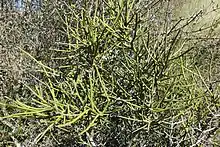| Carmichaelia petriei | |
|---|---|
 | |
| Scientific classification | |
| Kingdom: | Plantae |
| Clade: | Tracheophytes |
| Clade: | Angiosperms |
| Clade: | Eudicots |
| Clade: | Rosids |
| Order: | Fabales |
| Family: | Fabaceae |
| Subfamily: | Faboideae |
| Genus: | Carmichaelia |
| Species: | C. petriei |
| Binomial name | |
| Carmichaelia petriei | |
 | |
| Occurrence data from AVH | |
| Synonyms[3] | |
| |
Carmichaelia petriei is a species of New Zealand broom in the genus Carmichaelia. It is endemic to New Zealand. C. petrieis is possibly a host plant for the critically endangered fungus weevil Cerius otagensis.
Taxonomy
.jpg.webp)
Carmichaelia petriei was first described by Thomas Kirk in his book The students' flora of New Zealand and the outlying islands published in 1899. He named the plant in honour of Donald Petrie, the discoverer of the species.[4] The isolectotype specimen of C. petriei can be found at the Auckland War Memorial Museum.[5]
Description

Carmichaelia petriei is an upright but stout looking shrub, sparingly branched and growing up to 2.5 meters high and 2 meters wide. Its branchlets are coloured green, yellow green or bronze green and are leafless. Its flowers are coloured violet, purple and white and can be seen from November to January. The shrub produces seed from January to May.[4][6] It can be distinguished from other Carmichaelia species by the appearance of its seed pods which droop as they ripen and seeds that drop off when they reach maturity.[7]
Distribution
Carmichaelia petriei is endemic to New Zealand[6] and can be found in the South Island, as far north as the upper part of the Waitaki River Valley in Canterbury, as well as in the MacKenzie Basin, Otago and Southland including Stewart Island.[7]
Habitat
This species grows in scrub and tussock grassland among rocks in montane, lowland or coastal sites. It can be found in river gorges or on terraces, cliffs and in the margins of forests.[7]
Ecology
One of only four specimens of the critically endangered fungus weevil Cerius otagensis was collected from the beating of a C. petriei plant. That this weevil was collected from C. petriei implies that this species of Carmichaelia may be a host plant for that endangered insect.[8]
Conservation status
Carmichaelia petriei had a large stable population and was therefore classified by the Department of Conservation (DOC) as being "Not Threatened" in 2013.[9] but in 2017, it was reclassified as "At Risk - Declining".[1]
References
- 1 2 de Lange, P.J. et al."Conservation status of New Zealand indigenous vascular plants, 2017" (PDF). 2017. p. 9.
- ↑ "Carmichaelia petriei Kirk". www.theplantlist.org. The Plant List. Retrieved 22 May 2016.
- ↑ "Carmichaelia petriei Kirk, 1899 [as Carmichaelia Petriei]". www.nzor.org.nz/. Landcare Research. Archived from the original on 16 June 2016. Retrieved 22 May 2016.
- 1 2 Kirk, Thomas (1899). The students' flora of New Zealand and the outlying islands. Wellington, New Zealand: John Mackay. doi:10.5962/bhl.title.54373. Retrieved 22 May 2016.
- ↑ "Carmichaelia petriei". www.aucklandmuseum.com. Auckland War Memorial Museum. Retrieved 22 May 2016.
- 1 2 "Carmichaelia petriei Kirk". Flora of New Zealand. Landcare Research. Retrieved 22 May 2016.
- 1 2 3 Heenan, P. B. (1996). "A taxonomic revision of Carmichaelia (Fabaceae — Galegeae) in New Zealand (part II)". New Zealand Journal of Botany. 34 (2): 172–174. doi:10.1080/0028825X.1996.10410680.
- ↑ Streamlands and Curraghmore Conservation Resources Report DOCDM-133012 (Report). Land Information New Zealand. July 2007. Retrieved 22 May 2016.
- ↑ Lange, Peter J. de; Rolfe, Jeremy R.; Champion, Paul D.; Courtney, Shannel P.; Heenan, Peter B.; Barkla, John W.; Cameron, Ewen K.; Norton, David A.; Hitchmough, Rodney A. (2013). Conservation status of New Zealand indigenous vascular plants, 2012 (PDF). Wellington, N. Z.: New Zealand Department of Conservation. p. 39. ISBN 9780478149951. Retrieved 22 May 2016.
External links
 Data related to Carmichaelia petriei at Wikispecies
Data related to Carmichaelia petriei at Wikispecies Media related to Carmichaelia petriei at Wikimedia Commons
Media related to Carmichaelia petriei at Wikimedia Commons- Observations and images by citizen scientists logged in Naturewatch NZ
